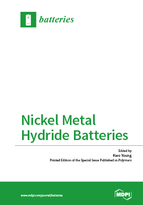Nickel Metal Hydride Batteries
A special issue of Batteries (ISSN 2313-0105).
Deadline for manuscript submissions: closed (15 May 2016) | Viewed by 181067
Special Issue Editor
2. BASF Battery Materials-Ovonic, 2983 Waterview Drive, Rochester Hills, MI 48309, USA
Interests: metal hydride alloy; nickel/metal hydride battery; proton-conducting battery; solid-state battery; solid-state hydrogen storage
Special Issues, Collections and Topics in MDPI journals
Special Issue Information
Dear Colleagues,
Nickel metal hydride (NiMH) batteries are presently used extensively in hybrid electric vehicles (HEVs). More than 10 million HEVs based on NiMH batteries have been manufactured and driven, and NiMH battery chemistry is expected to continue dominating the HEV market with its proven abuse tolerance, wide operating-temperature range, and durable service life. With the main goal of achieving higher gravimetric energy density while maintaining safety and robustness advantages, continuous efforts in improving the performances of NiMH batteries are very much needed in order to explore its possibility in other applications, such as battery-powered electric vehicles (BEV), stationary market, and more. Meanwhile, with the inherited high volumetric energy density, NiMH battery may have a chance to return to application in portable electronic devices. For this Special Issue of Batteries, papers of review, current research, and future projection in the materials, fabrication methods, cell integration and development, performance evaluation, failure analysis, and other subjects related to NiMH batteries are invited. Discussions and comments prior to manuscript submissions are also welcomed.
Dr. Kwo Young
Guest Editor
Manuscript Submission Information
Manuscripts should be submitted online at www.mdpi.com by registering and logging in to this website. Once you are registered, click here to go to the submission form. Manuscripts can be submitted until the deadline. All submissions that pass pre-check are peer-reviewed. Accepted papers will be published continuously in the journal (as soon as accepted) and will be listed together on the special issue website. Research articles, review articles as well as short communications are invited. For planned papers, a title and short abstract (about 100 words) can be sent to the Editorial Office for announcement on this website.
Submitted manuscripts should not have been published previously, nor be under consideration for publication elsewhere (except conference proceedings papers). All manuscripts are thoroughly refereed through a single-blind peer-review process. A guide for authors and other relevant information for submission of manuscripts is available on the Instructions for Authors page. Batteries is an international peer-reviewed open access monthly journal published by MDPI.
Please visit the Instructions for Authors page before submitting a manuscript. The Article Processing Charge (APC) for publication in this open access journal is 2700 CHF (Swiss Francs). Submitted papers should be well formatted and use good English. Authors may use MDPI's English editing service prior to publication or during author revisions.
Keywords
- nickel metal hydride battery
- electrochemical reaction
- battery performance evaluation
- hydrogen storage alloy
- nickel hydroxide






